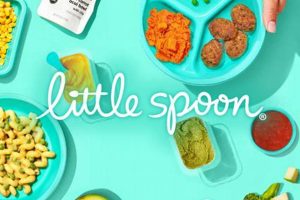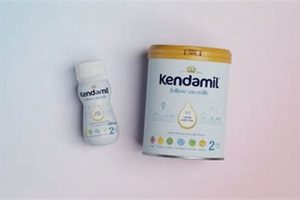The ability to bring sustenance for infants and toddlers onto commercial aircraft is a common query for traveling parents. Regulations and guidelines exist concerning the transportation of food items intended for young children during air travel. These provisions are in place to ensure both the safety and comfort of families while adhering to established security protocols.
Facilitating the nutritional needs of infants during travel offers significant benefits. It allows parents to maintain consistent feeding schedules, reduce stress associated with finding appropriate food options at airports or destinations, and mitigate potential health concerns arising from unfamiliar food sources. Historically, these considerations have led to gradual adjustments in security policies to accommodate the specific requirements of families with young children.
The subsequent sections will delve into the specific regulations regarding permissible quantities, acceptable packaging, and recommended procedures for declaring and transporting these items. Further discussion will address potential variations based on destination, airline, and security personnel discretion, offering practical guidance for navigating the complexities of traveling with infant nutrition.
The following guidelines offer practical advice for ensuring a smooth travel experience when transporting sustenance intended for infants and toddlers.
Tip 1: Verify Current Regulations. Always consult the Transportation Security Administration (TSA) website and the specific airline’s policies before travel. Regulations are subject to change, and proactive confirmation prevents potential issues at security checkpoints.
Tip 2: Adhere to Quantity Limits. While generally exempt from the 3.4-ounce (100ml) liquid rule, bring only reasonable quantities of baby food, formula, and breast milk. “Reasonable” is defined by the duration of the trip, not excessive surplus.
Tip 3: Proper Packaging is Essential. Ensure all baby food containers are securely sealed and appropriately labeled. Original packaging is preferable. If using reusable containers, clearly label the contents.
Tip 4: Declare at Security. Inform TSA officers that you are carrying baby food and related items. This proactive disclosure expedites the screening process and demonstrates transparency.
Tip 5: Be Prepared for Screening. Expect baby food to undergo additional screening. This may include X-ray, liquid testing, or visual inspection. Cooperation with security personnel ensures a swift process.
Tip 6: Consider Individual Airline Policies. Inquire about airline-specific guidelines regarding warming bottles or storing breast milk. Some airlines offer onboard refrigeration; confirming this beforehand is advisable.
Tip 7: Pack Smartly. Store baby food in an easily accessible location within carry-on luggage. This facilitates efficient removal for inspection at security and convenient access during the flight.
Tip 8: Allow Extra Time. Security screenings may take longer when traveling with infant nutrition. Allocate additional time to accommodate potential delays and minimize stress.
Adherence to these recommendations allows for a more convenient passage through airport security and ensures the availability of appropriate nourishment for infants throughout the journey.
The subsequent section will present potential challenges and solutions associated with travelling with baby food and formula.
1. Quantity Limits
The ability to bring sustenance for infants and toddlers on board aircraft is directly contingent upon adherence to quantity limits established by regulatory bodies. While generally exempt from standard restrictions on liquids, the permissibility of carrying infant food items is not unlimited. These limits exist to balance the needs of traveling families with security considerations. Exceeding established quantity limits can lead to confiscation of items or delays at security checkpoints.
The determination of “reasonable quantity” is often based on the duration of the flight and any layovers. For instance, a six-hour flight may warrant a greater volume of formula or baby food than a short domestic hop. Airlines and security personnel may request justification for the quantity being transported, therefore, parents should have an estimate of the infant’s consumption readily available. Instances of dispute often arise when travelers attempt to carry disproportionately large amounts of baby food, which can trigger further inspection or questioning.
In summary, understanding and respecting quantity limits is crucial for ensuring a smooth and compliant travel experience. The ability to transport necessary nutrition for infants rests on demonstrating responsible adherence to these regulations. Disregard for these limits introduces the potential for inconvenience and may ultimately compromise the intended goal of providing adequate sustenance during air travel.
2. Packaging Requirements
Packaging requirements are a critical determinant in the feasibility of transporting infant and toddler nutrition aboard commercial aircraft. Adherence to specific guidelines governing packaging directly influences the ability to successfully navigate security protocols and maintain the integrity of the food during transit. Non-compliance may result in delays, confiscation of items, or compromised food safety.
- Seal Integrity
The primary requirement is the integrity of the seal. Commercially prepared baby food must remain in its original, unopened packaging whenever possible. Tampered or opened containers may be subject to increased scrutiny or rejection by security personnel. This is because compromised seals raise concerns about potential contamination or undisclosed contents.
- Container Material
While glass containers are generally permitted, plastic or lightweight materials are often preferred to minimize the risk of breakage and reduce overall weight. Certain airlines may have restrictions on the use of glass containers in-flight due to safety concerns. Therefore, confirming airline policies prior to travel is recommended.
- Labeling and Identification
Clearly labeled containers are essential for easy identification. Original manufacturer labels provide comprehensive information about the product, ingredients, and nutritional value. If transferring baby food to reusable containers, clearly labeling the contents is crucial to avoid confusion and facilitate security screening. Lack of proper labeling can lead to delays or additional inspections.
- Leak-Proof Design
All containers must be leak-proof to prevent spills and contamination of other belongings. Securely sealed pouches or containers with tight-fitting lids are recommended. Placing containers in resealable plastic bags provides an extra layer of protection against leakage. Failure to adequately contain the contents can lead to inconvenience and potential hygiene concerns.
The combination of seal integrity, appropriate container material, clear labeling, and leak-proof design collectively dictates whether the transit of infant nutrition is permitted. By diligently adhering to these packaging requirements, traveling caregivers can significantly increase the likelihood of a seamless security experience and ensure the safe and hygienic transport of essential sustenance for their children.
3. TSA Notification
The process of informing Transportation Security Administration (TSA) personnel about carrying infant nutrition products is a crucial step for travelers. This notification facilitates a more streamlined security screening and helps prevent misunderstandings regarding the contents of carry-on luggage. Transparent communication with TSA officers is paramount for a trouble-free passage.
- Verbal Declaration
The most direct form of TSA notification involves verbally informing a TSA officer that baby food, formula, or breast milk is present in the traveler’s belongings. This verbal declaration should occur as carry-on items are placed on the conveyor belt for X-ray screening. This upfront disclosure allows the TSA officer to anticipate the presence of liquids exceeding the standard 3.4-ounce limit and prepare accordingly. For example, stating “I have baby food and formula in this bag” immediately sets the context for the screening process.
- Visual Identification
Organizing items within carry-on luggage in a manner that allows for easy visual identification of baby food and related products can also serve as a form of notification. Placing these items in a clear, accessible location within the bag enables TSA officers to quickly recognize their presence during the X-ray screening. This visual cue supplements the verbal declaration and further expedites the process. An example would be placing all baby feeding supplies in a dedicated compartment or clear bag within the larger carry-on.
- Proactive Inquiry
In situations where uncertainty exists regarding specific regulations or screening procedures, proactively inquiring with TSA officers about the proper handling of baby food is advisable. This proactive approach demonstrates a willingness to comply with security protocols and allows the traveler to receive clarification on any potential concerns. For instance, asking “What is the best way to present these baby food pouches for screening?” signals cooperative intent and ensures adherence to current guidelines.
These facets of TSA notification collectively contribute to a more efficient and predictable security experience for travelers carrying infant nutrition. Clear communication, both verbal and visual, combined with a willingness to seek clarification, allows TSA personnel to conduct screenings with minimal disruption and ensures that parents can transport essential sustenance for their children while adhering to established safety regulations. Failure to adequately notify TSA officers may lead to unnecessary delays, additional scrutiny, or, in some cases, the confiscation of items.
4. Screening Procedures
Screening procedures constitute a critical phase in determining whether the transport of infant nutrition is permissible aboard commercial aircraft. These protocols, implemented by security personnel, are designed to identify potential threats while simultaneously accommodating the needs of families traveling with young children. Adherence to these procedures is essential for a smooth travel experience.
- X-Ray Examination
All carry-on items, including baby food, formula, and breast milk, are subjected to X-ray examination. This non-invasive screening method provides security personnel with a visual representation of the contents within the bag, allowing them to identify any potentially prohibited items or irregularities. For example, X-ray imaging can reveal the presence of concealed objects within containers of baby food. Failure to comply with X-ray screening may result in denial of boarding.
- Liquid Testing
Baby food and formula exceeding the standard 3.4-ounce (100ml) limit may undergo additional liquid testing. This process involves using specialized equipment to detect the presence of explosive materials or other hazardous substances. Testing methods vary but often include placing a test strip into the liquid or scanning the container with a handheld device. If the liquid tests positive for prohibited substances, it will be confiscated. Conversely, a negative result allows the item to proceed.
- Visual Inspection
Security personnel may conduct visual inspections of baby food containers to verify the integrity of the packaging and confirm that the contents match the label. This inspection can involve opening the container to examine the texture, color, and odor of the food. If the visual inspection raises concerns about potential tampering or contamination, the item may be subject to further scrutiny or rejection. The visual inspection serves as a secondary verification method to complement X-ray and liquid testing.
- Explosives Trace Detection (ETD)
Explosives Trace Detection (ETD) is a technique used to detect microscopic traces of explosives on the exterior of containers. This process involves swabbing the container and analyzing the sample for the presence of explosive residue. ETD is often employed as an additional security measure when other screening methods yield inconclusive results or when security personnel have reason to suspect a potential threat. A positive ETD result typically leads to further investigation and potential confiscation of the item.
These facets of screening procedures collectively determine the permissibility of transporting infant nutrition on aircraft. X-ray examination, liquid testing, visual inspection, and ETD provide a multi-layered approach to security screening, balancing the need for safety with the practical requirements of families traveling with young children. Successfully navigating these procedures necessitates transparency, cooperation, and adherence to established guidelines.
5. Airline Policies
Airline policies are a critical component influencing the permissibility of transporting infant nutrition products on commercial flights. While Transportation Security Administration (TSA) guidelines provide a baseline for acceptable items, individual airlines retain the authority to implement supplementary restrictions or offer specific accommodations. Consequently, understanding airline-specific regulations is essential for travelers seeking to bring baby food, formula, or breast milk on board. These policies may encompass aspects such as quantity allowances, storage procedures, or onboard heating options.
A concrete example of the impact of airline policies is the variation in storage options for breast milk. While all airlines must adhere to TSA guidelines regarding the transport of breast milk, not all provide onboard refrigeration facilities. Some airlines may allow passengers to store breast milk in the aircraft’s refrigerator, while others do not offer this service. Similarly, policies on warming bottles can vary significantly. Some airlines may offer to warm bottles using hot water, while others may prohibit this practice due to safety concerns. Failing to ascertain these airline-specific policies beforehand can result in unanticipated difficulties during the flight, potentially compromising the infant’s feeding schedule.
In summation, airline policies are an indispensable consideration for travelers intending to carry infant nutrition products. While TSA regulations establish a general framework, airlines retain autonomy in implementing additional restrictions or providing specific onboard services. Proactive investigation of airline policies regarding quantity allowances, storage procedures, and heating options is crucial for ensuring a seamless and compliant travel experience. Neglecting to consider these airline-specific regulations may lead to inconveniences or necessitate alternative feeding strategies during the flight.
6. Destination Regulations
Destination regulations significantly impact the ability to transport infant nutrition on aircraft. These regulations, imposed by governing bodies of specific countries or regions, establish the permissibility of importing certain items, including baby food, formula, and breast milk. Discrepancies between TSA guidelines and destination regulations can create complexities for international travelers. For instance, while the TSA might permit a certain quantity of formula, the destination country may have stricter limitations on the importation of powdered milk products due to agricultural or health concerns. Non-compliance with destination regulations can lead to confiscation of items, fines, or even denial of entry. Examples include restrictions on dairy products in certain Asian countries or stringent labeling requirements for imported food items in the European Union. The importance of understanding these destination-specific rules cannot be overstated, as they supersede general guidelines established by the point of origin.
The practical implications of destination regulations manifest in several ways. Travelers must research the specific requirements of their destination country well in advance of their trip. This research should encompass import restrictions on baby food, formula, and breast milk, as well as any specific labeling or documentation requirements. Some countries may require health certificates or import permits for certain infant nutrition products. Failure to obtain the necessary documentation or adhere to labeling guidelines can result in the confiscation of these essential items upon arrival. A common scenario involves travelers arriving in a foreign country only to discover that their preferred brand of baby food is either unavailable or subject to import restrictions, highlighting the need for proactive planning and adherence to destination regulations.
In conclusion, destination regulations are an essential consideration for air travelers carrying infant nutrition. These regulations vary significantly across different countries and regions, potentially conflicting with standard TSA guidelines. Thorough research and adherence to destination-specific import restrictions, labeling requirements, and documentation protocols are crucial for ensuring a smooth and compliant travel experience. Overlooking these regulations can lead to significant inconveniences, financial penalties, or even denial of entry, underscoring the importance of proactive planning and compliance. The ability to transport necessary nutrition for infants rests upon a comprehensive understanding of, and adherence to, the regulations imposed by the final destination.
7. Accessibility Onboard
The capacity to transport sustenance for infants and toddlers aboard aircraft is directly related to the accessibility of these items during the flight. While regulations dictate what can be brought onto a plane, accessibility concerns the practical aspects of utilizing these provisions to adequately nourish a child during transit.
- Storage of Supplies
The availability of accessible storage space within the aircraft cabin is crucial. Overhead compartments or under-seat storage must be readily available for caregivers to store baby food, formula, and related feeding equipment. Limited storage capacity can hinder accessibility, forcing parents to keep these items in less convenient locations, potentially delaying feeding schedules or increasing the risk of spillage. For instance, lack of overhead space might necessitate placing a bag containing formula at one’s feet, making it difficult to retrieve during turbulence.
- Preparation Facilities
The presence of preparation facilities, such as access to hot water for warming bottles or designated areas for mixing formula, significantly impacts accessibility. While not all airlines offer such amenities, their availability directly influences the ease with which parents can prepare and administer infant nutrition. The absence of hot water, for example, might require caregivers to rely on cold formula or seek alternative warming methods, potentially compromising the infant’s comfort or nutritional intake.
- Crew Assistance
The level of assistance provided by flight attendants contributes to the overall accessibility of infant nutrition onboard. Attentive crew members can assist with tasks such as warming bottles, providing extra cups, or offering guidance on navigating airline policies. Limited crew support can place a greater burden on parents, particularly during long flights or when traveling alone. An attentive crew might proactively offer hot water for warming a bottle, whereas a less attentive crew might require the parent to seek out assistance and navigate potentially lengthy wait times.
- Space Constraints
The physical space available within the aircraft cabin directly impacts the accessibility of feeding infants and toddlers. Cramped seating arrangements or narrow aisles can make it difficult to maneuver, prepare food, or comfortably feed a child. Limited space may force parents to feed their child in awkward positions or restrict their ability to access necessary supplies. For example, a parent seated in a middle seat with limited legroom may find it challenging to comfortably hold and feed an infant, potentially leading to discomfort for both parent and child.
These elements of accessibility, in conjunction with regulations about what can be carried on board, determine the feasibility of effectively nourishing infants during air travel. Addressing these accessibility considerations is crucial for ensuring the well-being and comfort of both infants and their caregivers during air travel. By optimizing storage, preparation facilities, crew assistance, and spatial arrangements, airlines can significantly enhance the experience for families traveling with young children.
Frequently Asked Questions Regarding Infant Food Transport on Aircraft
The following addresses common inquiries concerning the carriage of nutrition intended for infants and toddlers during air travel, providing clarification based on established regulations and guidelines.
Question 1: Is there a limit to the quantity of baby food allowed in carry-on baggage?
While generally exempt from standard liquid restrictions, the quantity should be reasonable and commensurate with the duration of the flight. Excessive amounts may warrant further inspection by security personnel.
Question 2: Must baby food be in its original packaging?
Original, unopened packaging is preferable. However, if using reusable containers, clear labeling of the contents is essential for security screening purposes.
Question 3: Will baby food undergo additional screening at security checkpoints?
Expect baby food to undergo additional screening, which may include X-ray examination, liquid testing, or visual inspection, to ensure the absence of prohibited substances.
Question 4: Are there specific regulations regarding the transport of breast milk?
Breast milk is generally permitted in reasonable quantities. It does not need to be frozen or stored in a specific manner, but should be declared to TSA officers during security screening.
Question 5: What if the destination country has different regulations regarding baby food?
Destination country regulations supersede TSA guidelines. Researching import restrictions and labeling requirements for the destination is imperative to avoid potential issues upon arrival.
Question 6: Do airlines provide facilities for warming baby food or formula?
Airline policies vary. Confirming the availability of onboard warming facilities or other related services directly with the airline is advisable prior to departure.
Key takeaway: Compliance with established regulations, transparent communication with security personnel, and proactive planning contribute to a smooth and compliant experience when transporting infant food on aircraft.
The final section will provide a comprehensive conclusion, summarizing key points and offering definitive guidance.
The preceding discussion elucidates the intricacies surrounding the transportation of sustenance intended for infants and toddlers during air travel. Understanding and adhering to regulations established by both the Transportation Security Administration (TSA) and individual airlines is paramount. Permissible quantities, packaging protocols, security screening procedures, and destination-specific import restrictions collectively determine the feasibility of carrying baby food, formula, and breast milk aboard commercial flights. Transparency and proactive engagement with security personnel, coupled with meticulous pre-flight preparation, contribute to a smoother transit.
The ability to provide appropriate nutrition for infants during air travel is essential for ensuring their well-being and comfort. As regulations continue to evolve in response to security concerns and societal needs, ongoing awareness and diligent compliance remain the responsibility of traveling caregivers. Consistent adherence to guidelines fosters a secure environment for all passengers while safeguarding the nutritional needs of infants and young children during air travel.







